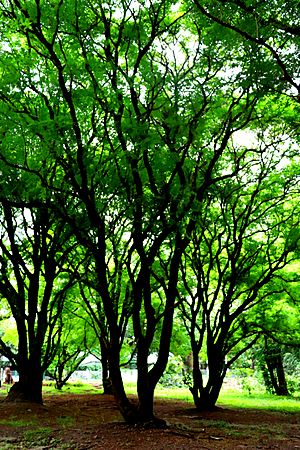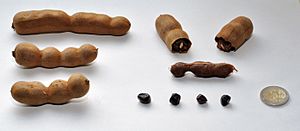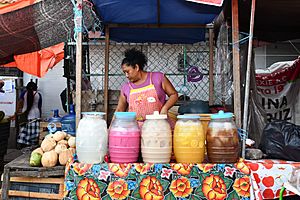Tamarindo (drink) facts for kids
| Type | Aguas frescas |
|---|---|
| Country of origin | Mexico |
| Colour | Reddish brown |
| Flavour | Sour-sweet |
| Ingredients | Tamarind, water and sugar |
Tamarindo, also called agua de tamarindo, is a refreshing drink. It is made from tamarind fruit, sugar, and water. This drink does not contain alcohol. The tamarind plant first grew in Africa. Now, you can find it all over the world, especially in warm, tropical places.
Tamarind trees grow fruit pods that hold a soft pulp and seeds. The pulp is the most used part of the plant. It can taste both sour and sweet. This makes tamarindo a unique sour-sweet drink. It is a very popular type of aguas frescas. Aguas frescas are traditional drinks in Latin America. Tamarindo is easy to make at home with just three ingredients. Big companies like Jarritos and Nestle also make and sell tamarindo soda around the world.
Contents
The Story of Tamarindo
The tamarind plant comes from Africa. People there often used it for shade. By the 4th century BC, the Greeks and ancient Egyptians knew about tamarind. Since then, it has spread to over 50 countries. It is very common in Asia, especially India, and in Latin America.
Tamarind came to Mexico in the 16th century. There, it became a popular flavor for aguas frescas. Aguas frescas are non-alcoholic drinks. They are made with water, sugar, and fresh fruits, seeds, grains, or flowers. You can find them mostly in Mexico and other Latin American countries. They are also popular in the United States now.
People often buy aguas frescas from street vendors. You can also find them in restaurants. They are usually served in a special Mexican glass jar called a vitrolero. People enjoy them with meals or as a cool drink on warm days. Tamarindo is one of many popular aguas frescas flavors. Others include horchata and hibiscus.
What's in Tamarindo?
Tamarindo is made from three simple things: tamarind, water, and sugar.
All About Tamarind
The main ingredient in tamarindo is tamarind. Its scientific name is Tamarindus indica L. It is a type of legume, like beans or peas. Tamarind trees grow in tropical areas. They can reach up to 24 meters (about 79 feet) tall. These trees produce a lot of fruit. They usually give fruit for 50 to 60 years. Some can live for over 200 years!
Tamarind trees grow brown fruit pods. Inside each pod are one to twelve reddish-brown seeds and soft pulp. Tamarind fruit has a lot of tartaric acid. This acid is also in other sour fruits like raspberries and grapes. The taste of the pulp changes with how ripe the fruit is. Riper tamarind tastes sweeter. This is because it has more sugar, which balances the tartaric acid.
The pulp is the most used part of the tamarind plant. It has many carbohydrates (41.1 to 61.4 grams per 100 grams). It has very little fat (0.6 grams per 100 grams). Tamarind pulp is also rich in vitamins and minerals. These include potassium, calcium, and phosphorus.
Tamarind seeds are also used as food. They have a lot of protein (26.9 grams per 100 grams) and oil. In some places, tamarind seeds are used as emergency food. This is because of their high protein content. Even the leaves of the tamarind plant are eaten by animals. They are high in calcium and protein.
How Tamarind is Grown
A mature tamarind tree can produce a lot of fruit. Some can make up to 150 to 225 kilograms (about 330 to 496 pounds) of fruit each year. On average, they produce 30 to 50 kilograms (about 66 to 110 pounds) annually. Most tamarind grown worldwide is the sour kind. This makes up 95% of all tamarind production.
India and Thailand are the biggest tamarind producers in Asia. Mexico is the largest producer in the Western world. Most African countries do not grow tamarind for sale. However, local people use it often.
What Tamarind is Used For
Almost every part of the tamarind tree is useful. This includes the wood, bark, flowers, leaves, pulp, and seeds. People use them for business, cooking, and even medicine.
Business Uses
Tamarind trees are great for shade. They are also used as ornamental trees in parks and along roads. Tamarind seeds are used to make tamarind kernel powder. This powder helps fabrics absorb water and swell up. It is used in the textile industry. In India, it helps make cotton. In Bengal, tamarind seeds are used to make an oil for varnishes. The wood is used for making furniture and wheels. The leaves and flowers help set dyes.
Cooking Uses
Tamarind pulp is most often used in cooking. It is found in many chutneys, curries, and sauces. Examples include Worcestershire sauce and barbecue sauce. It is also used in drinks like tamarindo. In Sri Lanka, tamarind pulp is used instead of lime. In Senegal, it is mixed with sugar to make sweet treats. In India, tamarind pulp juice helps preserve fish. In East Africa, the pulp is used in a dish called ‘ugali’. This is a type of maize flour porridge.
In Puerto Rico, tamarind syrup is made from the fruit. Street vendors use it to flavor shaved ice. Tamarind seeds can also be used in cooking. But you cannot eat them raw. They need to be soaked and boiled first. The seeds are often used in jellies, marmalades, and jams. This is because they contain pectin, which helps them set. They also help stabilize cheese, ice cream, and mayonnaise. In Indonesia, roasted tamarind seeds are eaten as a snack with salt and coconut. In Thailand, tamarind seeds are used as a coffee substitute.
Medicinal Uses
Different parts of the tamarind plant have been used for medicine around the world. In Nigeria, tamarind roots are used to treat certain skin conditions. In America, tamarind pulp has been used as a laxative. It also helps with things like sunstroke and sore throats. In Thailand, the pulp has been made into tablets to help with weight. In Brazil, the pulp is used for its moisturizing effects. It is also used in traditional medicine for colds, diarrhea, and to reduce swelling.
Tamarind seeds, when powdered, have been used in India and Cambodia to help with stomach issues. In Ethiopia, softened tamarind seeds are used to get rid of parasitic worms. The bark of the tamar tamarind tree is used in Uganda to treat malaria. In the Philippines, it is made into lotions for skin problems.
How Tamarindo is Made
There are different ways to make tamarindo. Usually, you start by taking the pods off the tamarind fruit. Then, you add them to boiling water. The pods soak for about 45 minutes. After soaking, you remove the seeds. This leaves the pulp. The pulp is then strained through a sieve. Finally, it is blended with water and sugar.
You can also buy tamarind pulp from the store. This saves time when making the drink. Once all the ingredients are mixed, tamarindo is served over ice. Making it usually takes 45 minutes to an hour. This depends on whether you use fresh pods or store-bought pulp. When tamarindo is made for commercial sale, it is often carbonated. This makes it like a soft drink.
Tamarindo, made with tamarind pulp, is good for you. It is a good source of potassium, calcium, and carbohydrates. It also has high levels of Vitamin B (like Vitamin B1 - thiamine and Vitamin B3 - niacin). It even has small amounts of Vitamin C.
Who Makes and Sells Tamarindo?
Tamarindo is often sold by street vendors in Latin America. Street vendors are very important in Latin American culture. They provide many jobs for local people. They sell food, drinks, clothes, and other everyday items. Immigrants have also brought street vending to the United States. This helps them feel more at home.
Tamarindo and other aguas frescas are common at street vendors, taquerias, and restaurants. You can find them in Latin America and the United States. Now, many companies make tamarindo commercially. These include Jarritos and Nestle. They sell it all over the world.
Jarritos is a Mexican soft drink company. It started in 1950. Now, its drinks are sold in the United States and other countries. Jarritos offers many flavors, including Tamarindo. Other flavors are Mandarin, Lime, and Guava. Nestle, a global food and drink company, also sells tamarindo. In 2011, Nestle introduced three Latin American flavors in the United States. These were Tamarindo, Horchata, and Jamaica.
Other Tamarind Drinks
There are several drinks similar to tamarindo. They all use tamarind as their main ingredient.
Poha Beer
Poha Beer is a tamarind drink from Ghana. It is made mostly from tamarind pulp. Spices like ginger and peppercorn are also added. Making Poha Beer involves several steps. First, the fruit's outer covering is removed. Then, the fruit is covered in water and left to ferment. Next, the fruit is shaped into balls. The pulp is then taken out by soaking the fruit in water. The fruits are mashed to get more pulp. Unwanted parts are removed. Finally, spices like ginger and peppercorns are added for flavor.
Nam Ma Kham Wan
Nam Ma Kham Wan is a popular drink in Thailand. It is made with tamarind pulp, water, salt, and sugar. The tamarind pulp is mixed and blended with water. Then, it is boiled. Salt and sugar are added to the mixture. After that, it is cooled and served over ice.
Nuoc Da Me
Nuoc Da Me is a tamarind drink from Vietnam. It is very simple to make. Tamarind pulp is mixed with sugar and water. Then, it is served over ice with water and any type of nut, usually peanuts.
Imli Ka Amlana
Imli Ka Amlana is a tamarind drink from India. It is made by mixing tamarind pulp with various spices. These usually include black salt, black pepper, cardamom powder, and cumin powder. Sugar is also added. It is served chilled over ice. A company called Paper Boats used to sell Imli Ka Amlana. However, they no longer make it.





